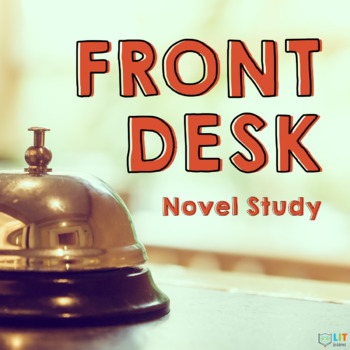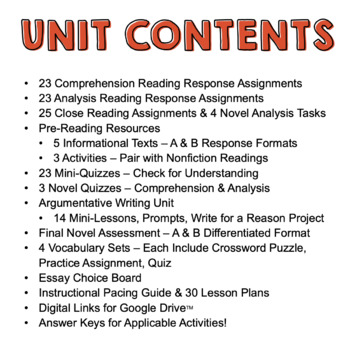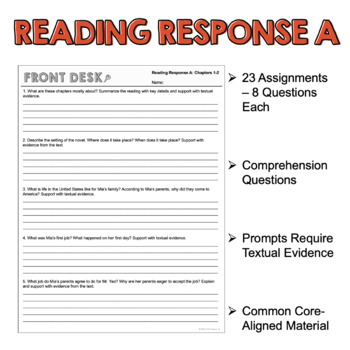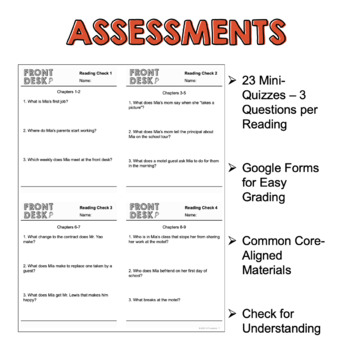Front Desk Novel Study
- Zip
What educators are saying
Products in this Bundle (6)
showing 1-5 of 6 products
Bonus
Description
The Front Desk Novel Study is a comprehensive novel study for teaching Front Desk by Kelly Yang. With over 100+ Common Core aligned materials, students will develop their literacy skills while deeply engaging with the novel through this 6-WEEK unit. The fiction close reading activities, the literary analysis resources, pre-reading resources, vocabulary, assessments, argumentative writing unit, and essays will all provide opportunities for your students to practice and apply what will be their growing understanding of the novel. They also provide numerous ways for you to DIFFERENTIATE and ACCOMMODATE for all learners, allowing you to choose the assignments that best support your students’ learning while being conducive to all types of classroom models.
Snapshot of Resources Included in Unit:
- 30 Common Core Aligned Lesson Plans
- 23 Reading Response A (Comprehension) Assignments & 19 Reading Response B (Analysis) Assignments
- 25 Close Reading Assignments (Literary Skills-Based) & 4 Whole Novel Analysis Assignments
- Pre-Reading Resources - 5 Informational Texts & Questions - History of Chinese Immigration & 3 Activities
- Argumentative Writing Unit - 14 Mini-Lessons, Prompts, Write for a Reason Project
- Vocabulary Resources - 4 Crossword Puzzles, 4 Practice Exercises, 4 Quizzes
- Assessment Resources - 23 Mini-Quizzes, 3 Comprehension Quizzes, Differentiated Final Test, Essay Choice Board
- Answer Keys for ALL applicable resources!
- Googles Slides™ & Google Forms™ links for student pages!
Digital Compatibility: This resource is also technology friendly! It can be utilized in classrooms where computers or tablets are central to instruction because the resource has been adapted for digital completion. The resources include links for students to complete any work assigned, such as in-class tasks and assessments, online via Google Slides™ and Google Forms. For instance, students can work with the documents in Google Drive™ or via Google Classroom. With these links, you can have students complete their activities, assignments, and ALL ASSESSMENTS online. All they will have to do for the student pages is either create a text box or fill out a form! There are links for every student page and assessment if applicable, making the format friendly not only for technology but also trees.
Reading Response Resources: The comprehension and literary analysis resources for Kelly Yang's Front Desk will give students repeated opportunities to practice essential literacy skills aligned to the Common Core State Standards. For every chapter grouping, students will have to answer rigorous, text-based questions that assess not only their ability to comprehend but also their ability to analyze key events. With numerous options for implementation, the resource also allows for differentiation and can enable accommodation that will meet the needs of all learners. There are two sets of questions for each reading: Reading Response A (comprehension) and Reading Response B (analysis). The twin sets offer different levels of challenge for students to give you options for meeting the needs of all your learners. All 46 assignments include 8 questions that require close reading of the text, which means your students will always be practicing essential skills aligned to the CCSS.
Close Reading Resources & Graphic Organizers: Through the 25 close reading activities and 4 whole novel analysis assignments, students will engage at a deeper level with Front Desk. The resource provides them repeated opportunities to apply their understanding of essential literary elements. Its rigorous tasks also encourage close reading and the use of textual evidence. With numerous options for implementation, the resource also allows for differentiation and can enable accommodation that will meet the needs of all learners.
Pre-Reading Resources: The Front Desk pre-reading resources will build your students’ understanding of the history of Chinese immigration to the United States, a topic that shapes the novel. By developing an understanding of this history, students will be able to engage with the themes of Front Desk in a thoughtful way. Instead of learning the characters’ experiences as isolated incidences, they will build their capacity to see these events on a continuum of history that continues to shape and influence society today. As they do, they will also develop essential literacy and critical thinking skills. The resource includes 5 nonfiction readings, 3 activities, and an anticipation guide.
Argumentative Writing Resources: The Front Desk writing resources teaches students argumentative writing through 14 mini-lessons, an essay assignment, and a final project. Each element of an argumentative essay is broken down and modeled before providing students the opportunity to draft their own example. Writing instruction also requires a lot of flexibility, especially since the expectations between grades varies widely. As a result, the student pages are editable to suit your specific, classroom needs. Need the resources to reflect fifth grade opinion standards? The editable student pages allow you to make those changes. With mini-lessons on thesis statements, topic sentences, conclusions and more, the resources provide a comprehensive resource for teaching this type of essay.
Assessment Resources: The Common Core aligned assessments will help you measure your students’ comprehension of the text and their ability to apply the literary skills taught throughout the unit. The materials include 23 reading checks, 3 comprehension and literary quizzes, 1 differentiated literary assessment, and essay choice board.
Vocabulary Resources: The Front Desk vocabulary resources will assist students in building their own vocabulary and engage them in varied activities to maximize their vocabulary’s expansion. With the 4 different vocabulary lists, 4 crossword puzzles, 4 vocabulary practice assignments, and 4 quizzes the resource allows for differentiation and flexible implementation.
Teaching Resources (Bonus Material): The unit implementation suggestions, standards-alignment guide, pacing guide, and 30 lesson plans will help you effectively plan and implement any and all components of the unit. They are the materials designed for you. (Editable)
Answer Keys: Every resource includes comprehensive answer keys! The keys provide potential answers for every activity, lesson, and question (where applicable). Of course, not all analytic questions have just one answer! Part of the strength of the analysis question is the room they leave for students to demonstrate their unique thinking and use textual evidence to support their stance. Therefore, use the answers at your discretion but know they provide a solid foundation for the type of performance that makes for quality work.
With the exception of the writing resources, this resource is NOT EDITABLE! It is intended to be comprehensive, but if you have particular needs for your classroom, please contact me! (lauren@lit-lessons.com)





